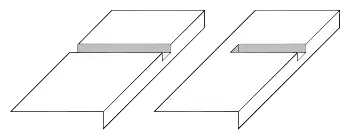Dado (joinery)
A dado (US and Canada), housing (UK) or trench (Europe) is a slot or trench cut into the surface of a piece of machinable material, usually wood. When viewed in cross-section, a dado has three sides. A dado is cut across, or perpendicular to, the grain and is thus differentiated from a groove which is cut with, or parallel to the grain. Dados are often used to affix shelves to cabinetry bodies. Similar to the dado, see rabbet (rebate).

A through dado (left) and a stopped dado
Variations
- A through[1] dado involves cuts which run between both edges of the surface, leaving both ends open.
- A stopped or blind[2] dado ends before one or both of the cuts meets the edge of the surface.
- A half dado is formed with a narrow dado cut into one part, coupled with a rabbet of another piece. This joint tends to be used because of its ability to hide unattractive gaps due to varying material thicknesses.[3]
References
- Mortise and Tenon Frame Joints, WoodworkDetails.com
- Making Perfect Rabbet and Dado Joints AmericanFurnitureDesgn.com
- William D. Umstattd; Charles W. Davis (2005). Modern cabinetmaking. Goodheart-Willcox. p. 484. ISBN 1590703766.
This article is issued from Wikipedia. The text is licensed under Creative Commons - Attribution - Sharealike. Additional terms may apply for the media files.